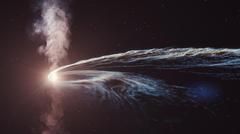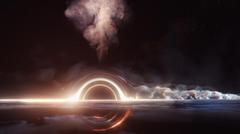URL: https://www.desy.de/news/news_search/index_eng.html
Breadcrumb Navigation
DESY News: Ghost particle from shredded star reveals cosmic particle accelerator
News
News from the DESY research centre
Ghost particle from shredded star reveals cosmic particle accelerator
Tracing back a ghostly particle to a shredded star, scientists have uncovered a gigantic cosmic particle accelerator. The subatomic particle, called a neutrino, was hurled towards Earth after the doomed star came too close to the supermassive black hole at the centre of its home galaxy and was ripped apart by the black hole's colossal gravity. It is the first particle that can be traced back to such a 'tidal disruption event' (TDE) and provides evidence that these little understood cosmic catastrophes can be powerful natural particle accelerators, as the team led by DESY scientist Robert Stein reports in the journal Nature Astronomy. The observations also demonstrate the power of exploring the cosmos via a combination of different 'messengers' such as photons (the particles of light) and neutrinos, also known as multi-messenger astronomy.

Smoking gun: After the supermassive black hole tore the star apart, roughly half of the star debris was flung back out into space, while the remainder formed a glowing accretion disc around the black hole. The system shone brightly across many wavelengths and is thought to have produced energetic, jet-like outflows perpendicular to the accretion disc. A central, powerful engine near the accretion disc spewed out these fast subatomic particles. Credit: DESY, Science Communication Lab
About half of the star's debris was flung into space, while the other half settled on a swirling disc around the black hole. This 'accretion disc' is somewhat similar to the vortex of water above the drain of a bathtub. Before plunging into oblivion, the matter from the accretion disc gets hotter and hotter and shines brightly. This glow was first detected on 9 April 2019 by the Zwicky Transient Facility (ZTF) - a robotic camera at Caltech's Palomar Observatory in Southern California.
Half a year later, on 1 October 2019 the IceCube neutrino detector at the South Pole registered an extremely energetic neutrino from the direction of the tidal disruption event. “It smashed into the Antarctic ice with a remarkable energy of more than 100 teraelectronvolts,” says co-author Anna Franckowiak from DESY, who is now a professor at the University of Bochum. “For comparison, that's at least ten times the maximum particle energy that can be achieved in the world's most powerful particle accelerator, the Large Hadron Collider at the European particle physics lab CERN near Geneva.”
Extreme lightweight
The extremely lightweight neutrinos hardly interact with anything, able to pass unnoticed through not just walls but whole planets or stars, and are hence often referred to as ghost particles. So, even catching just one high-energy neutrino is already a remarkable observation. Analysis showed that this particular neutrino had only a one in 500 chance of being purely coincidental with the TDE. The detection prompted further observations of the event with many instruments across the electromagnetic spectrum, from radio waves to X-rays.
“This is the first neutrino linked to a tidal disruption event, and it brings us valuable evidence,” explains Stein. “Tidal disruption events are not well understood. The detection of the neutrino points to the existence of a central, powerful engine near the accretion disc, spewing out fast particles. And the combined analysis of data from radio, optical and ultraviolet telescopes gives us additional evidence that the TDE acts as a gigantic particle accelerator.”

Heart of darkness: A view of the accretion disc around the supermassive black hole, with jet-like structures flowing away from the disc. The extreme mass of the black hole bends spacetime, allowing the far side of the accretion disc to be seen as an image above and below the black hole. Credit: DESY, Science Communication Lab
The cosmic accelerator spews out different types of particles, but apart from neutrinos and photons, these particles are electrically charged and thus deflected by intergalactic magnetic fields on their journey. Only the electrically neutral neutrinos can travel on a straight line like light from the source towards Earth and so become valuable messengers from such systems.
“The combined observations demonstrate the power of multi-messenger astronomy,” says co-author Marek Kowalski, head of neutrino astronomy at DESY and a professor at Humboldt University in Berlin. “Without the detection of the tidal disruption event, the neutrino would be just one of many. And without the neutrino, the observation of the tidal disruption event would be just one of many. Only through the combination could we find the accelerator and learn something new about the processes inside.” The association of the high-energy neutrino and the tidal disruption event was found by a sophisticated software package called AMPEL, specifically developed at DESY to search for correlations between IceCube neutrinos and astrophysical objects detected by the Zwicky Transient Facility.
Tip of the iceberg?
The Zwicky Transient Facility was designed to capture hundreds of thousands of stars and galaxies in a single shot and can survey the night sky particularly fast. At its heart is the 1.3 m diameter Samuel-Oschin Telescope. Thanks to its large field of view, ZTF can scan the entire sky over three nights, finding more variable and transient objects than any other optical survey before it. “Since our start in 2018 we have detected over 30 tidal disruption events so far, more than doubling the known number of such objects,” says Sjoert van Velzen from Leiden Observatory, co-author of the study. “When we realised that the second brightest TDE observed by us was the source of a high-energy neutrino registered by IceCube, we were thrilled.”
“We might only be seeing the tip of the iceberg here. In the future, we expect to find many more associations between high-energy neutrinos and their sources,” says Francis Halzen, Professor at the University of Wisconsin-Madison and Principal Investigator of IceCube, who was not directly involved in the study. “There is a new generation of telescopes being built that will provide greater sensitivity to TDEs and other prospective neutrino sources. Even more essential is the planned extension of the IceCube neutrino detector, that would increase the number of cosmic neutrino detections at least tenfold.” This TDE marks only the second time, a high-energy cosmic neutrino could be traced back to its source. In 2018, a multi-messenger campaign presented an active galaxy, the blazar TXS 0506+056, as the first ever identified source of a high-energy neutrino, recorded by IceCube in 2017.
The IceCube Neutrino Observatory is a facility of the U.S. National Science Foundation operated at the Amundsen-Scott South Pole Station under the U.S. Antarctic Program. Apart from IceCube and ZTF, the instruments Spectral Energy Distribution Machine (SEDM), Palomar 200-inch Hale Telescope (P200), Liverpool Telescope (LT), NASA's Neil Gehrels Swift Observatory, Lowell Discovery Telescope, Lick Observatory Shane Telescope, Keck Telescope, ESA's X-ray Multi-Mirror Mission (XMM-Newton), Karl G. Jansky Very Large Array (VLA), AMI Large Array (AMI-LA), MeerKAT, and NASA's Fermi Large Area Telescope (Fermi-LAT) provided observational data for the study.
Reference:
A tidal disruption event coincident with a high-energy neutrino; Robert Stein, Sjoert van Velzen, Marek Kowalski, et al.; Nature Astronomy, 2021, DOI: 10.1038/s41550-020-01295-8
A concordance scenario for the observed neutrino from a tidal discruption event; Walter Winter and Cecilia Lunardini; Nature Astronomy, 2021, DOI: 10.1038/s41550-021-01305-3



